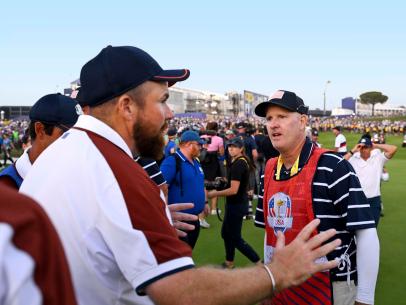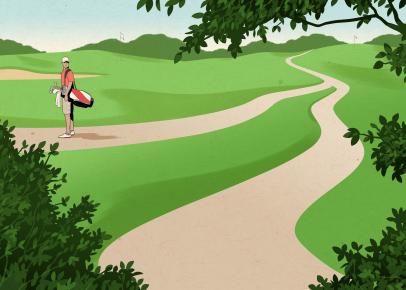Undercover Caddie: How team events can upset the looper-player dynamic – Australian Golf Digest

- by Admin
- September 20, 2024

Another Presidents Cup is near, which is a good time to discuss team events. It’s an honor to go to the Ryder Cup and Presidents Cup. It means you’re with a player who had a good year, you made good money (even better now in this new era of $20 million purses) and you likely have job security. It means you matter. But how much these team events matter to us varies.
The Ryder Cup has always had a kick to it, but now players treat it with a solemnity seen only at the majors. Caddies for the American and International sides used to view the Presidents Cup as a burden. I know this because I’ve worked both sides. One year my International player said I didn’t have to go with him if I wanted the week off. Today, making a Presidents Cup team for an American is almost up there with qualifying for the Ryder Cup.
Players and fans treating these events like premier sporting events has enhanced the vibe. It’s as close as we get to a college football atmosphere. Given how many American players and caddies come from the football-crazed South, it’s hard to convey what an amped-up crowd and perceived higher stakes do for your adrenaline, expectation and excitement. I hate to use the term goose bumps, but when you enter these first-tee amphitheaters or hear fans belting out songs and anthems, it goes right to your bones.
Some caddies really get into it. For example, the great Billy Foster, caddie for 2022 U.S. Open champion Matthew Fitzpatrick, genuinely views himself as part of the team. When his side wins, it makes his year. When his side goes home with the L, it’s like a part of him dies. (I say “side” because although he has worked more than a dozen Ryder Cups for Europe, you might forget he was with Tiger Woods at the 2005 Presidents Cup.) Former caddie-turned-broadcaster John Wood is in there as well. They arguably love those events more than anything else; Wood now even has a specific roll as a U.S. team manager for the Ryder Cup. And then there was the passion shown by Joe LaCava, on the bag of Patrick Cantlay at the 2024 Ryder Cup in Rome and defending him against fans and players alike.
Then there are others, like me. It’s not that I dislike team match-play events, but players and caddies are creatures of habit, and a Presidents or Ryder Cup week throws that cadence, and in ways the player-caddie dynamic, into the blender.
Here’s the way I’ve described it to caddies who haven’t been. You hear players talk about “team” a lot, right? Agents, managers, instructors, physios, chefs—they are all part of the team, but a lot of those folks are on the periphery. When things really matter, it’s just the player and caddie inside the ropes. What happens there, good and bad, creates a bond. To us, that is the team.
More From Golf Digest+ Golf Digest Logo Undercover Caddie: Breaking down the Rory McIlroy-Joe LaCava heated exchange Ryder Cup exchange  Golf Digest Logo How a sentimental letter helped this Hall of Famer become a Presidents Cup captain
Golf Digest Logo How a sentimental letter helped this Hall of Famer become a Presidents Cup captain  Golf Digest Logo Undercover Caddie: Did I make a mistake choosing this line of work?
Golf Digest Logo Undercover Caddie: Did I make a mistake choosing this line of work?
At the Ryder Cup and Presidents Cup, that player-caddie “team” dynamic transitions to the 12 respective players on each side. The camaraderie among them is unlike anything they have during the season. Getting everyone to concentrate on one goal under one flag develops a certain fellowship. For years I heard that the Europeans weren’t as close as they were made out to be during Ryder Cups, but I’ve seen that phenomenon up close, and that bond is real, as it should be. As a consequence, caddies are the ones pushed to the periphery, ever so slightly, and though some caddies don’t take it personally, for me, the emotional investment isn’t quite the same.
This is especially true for those who caddie for a different nationality. It can be hard for an American looper facing the American team, or a European or International caddie doing the same. You’re obviously hoping to do the best you can for your guy and your team, and we say it’s not a loyalty divided. However, I’ve been in that position, and it’s weird. It just is, and anyone who says differently is lying.
Team events can also go a little too far. Although those special moments do resonate—the first-tee atmosphere, sinking a huge putt to go from dead in the water to daggering your opponent, winning or halving a point when no one thought you could—a lot of the forced yelling and fist pumps and gamesmanship for moments that don’t deserve them rankle me. For example, my player made a six-foot putt a few years back to halve a hole early in the match and yelled, “Let’s go!” to the crowd like he just won the Masters, only it was the first day of the event, and we were already down 3.
Ultimately, I do dig these events. They raise the stature of a caddie just like they do for a player. I still wouldn’t trade any of our tour victories for any of the Cups I’ve been to, but it is a nice accomplishment for the résumé. Whatever reservations I have toward team events, I’ll admit, the few that I missed I wished I was there. It’s a little like getting to sit with the cool kids at lunch: Once you’re there, you don’t want to not be there.
My favorite part? That camaraderie that develops among players happens with the caddies, too. We’re already a fraternal bunch, and this turns it up more. We’ll do our course scouts together and trade notes. It’s also cool to see the other caddies, when their players are sitting out, come follow our group to root us on. Seeing the fist-pumps and hearing the attaboys from them means just as much, if not more, than anything produced by the fans. The caddie room, however, is what’s really special. Those meetups are legendary. We all understand the position we’re in, and to be honest, we get after it. Some of the stories and shenanigans make their way out of the room and back to the players, and you can tell they’re bummed they missed out. Imagine that: players jealous of caddies. —With Joel Beall
EDITOR’S NOTE—This story has been updated since it first published in September 2022 ahead of the Presidents Cup played at Quail Hollow Club.
This article was originally published on golfdigest.com
The Latest News
-
November 15, 2024Nick Kyrgios set to make long-awaited return to tennis as comeback date revealed
-
November 15, 2024List wins elusive DP World Tour card, Barron loses his
-
November 15, 2024India great warns ‘the king is back in his territory’ as struggling Virat Kohli returns for fifth tour
-
November 15, 2024‘Adaptable’ Murphy spins out WA to put Vics in control | cricket.com.au
-
November 15, 2024Nick Kyrgios: Australian tennis star confirms return to ATP Tour at Brisbane International in December





